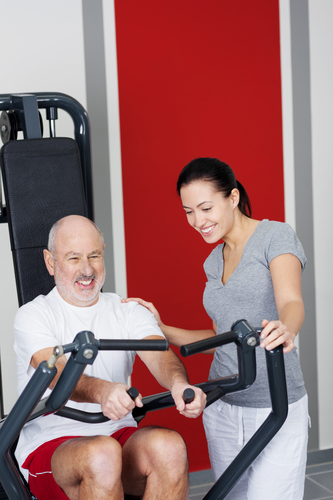Once upon a time, exercising used to have a uniform and a regiment specific for men and women.
Men would suit up in short shorts, beach themed tank tops, white headbands, wrist-bands, calf high knee socks, and white New Balance shoes.
Women would shimmy into their sleek leotards, heads decorated with colorfully braided headbands, legs adorned with scrunchie leg warmers, and feet comforted by puffy, linen white high-tops.
Middle-aged couples would venture into the “health club” and go their separate ways. The men would veer to the left and head to the land of Nautilus and the women would head to a music-filled room with a stage and lots of steps. They may tinker around with some free weights, do some floor work, or sit-ups, and the workout would inevitably end up with a 20-minute cardio session on a bike or treadmill.
Yup folks, that was the 80’s, that is how my parents worked out, and sadly, that is how 8 out of 10 middle aged movement warriors still workout today.
Now the outfits may have changed and the gym offerings may have evolved, but I am telling you, after working in gyms for years, this is still the workout of choice.
Why? Because that is all people know, it’s “simple, safe & effective,” and it’s what they’ve always done. Sadly, the fitness plan of choice is:
- Find a gym
- Sit on some weight machines (maybe do some dumbbell bicep curls)
- Do some cardio (preferably in place, not going anywhere)
- Find a low impact aerobics class
This standard, one size fits all exercise plan is what most of my clients affected by medical conditions, chronic pain, and recurring injuries have been recommended to do by a majority of the medical community most of their lives.
Here’s the truth…that plan is ineffective.
While many fitness professionals champion all types of movement as good and celebrate people just moving and becoming more active, the industry MUST find a way to deliver more powerful fitness plans and recommend exercises to directly target the physiological problems arising from medical conditions. With the current state of our nation’s health, insurance landscapes, and health care demands, we must start equipping ourselves as health care providers and we must master a new skill set.
The Need for Evolution
 The fitness field must evolve because there is a wave of potential clients that will flood the fitness industry over the next decade. They will have chronic pain, recurring injuries, and complex medical conditions that traditional fitness training and novice personal trainers will not be able to handle.
The fitness field must evolve because there is a wave of potential clients that will flood the fitness industry over the next decade. They will have chronic pain, recurring injuries, and complex medical conditions that traditional fitness training and novice personal trainers will not be able to handle.
Changes in health care and the insurance industry have mandated the use of exercise as a strong component of the medical management of chronic diseases. However, despite the ample amount of research supporting the positive impact of exercise on medical conditions, the actual integration of exercise programming and guidelines into healthcare has been challenging. The reason is due to the fact that the fitness industry has tried to “modify” itself into the medical field without equipping its experts with the understanding of the needs of the medical community and its patients. Furthermore, the medical community has not been properly informed or been given the opportunity to partner with fitness professionals that truly understand their patients’ needs.
This is why Medical Fitness has developed.
The Rise of Medical Fitness
General fitness programs cannot adequately meet the needs of the medically-based client. Medical exercise/ fitness is specifically focused on resolving the client’s functional deficits remaining after illness, injury or surgery once they are discharged from physical therapy and/or medical treatment. Medical Exercise Training programs focus on delivering condition-specific exercise and lifestyle programs to improve the quality of each individual’s life with measurable results that can be effectively communicated and coordinated with the medical community.
Clients who do not have 8% body fat, or cannot throw a barbell over their head, should not be pushed to the point of insanity when it comes to workout intensity.
The average person, the ones we seek to help, our Medical Fitness tribe if you will, have bodies that:
- Have artificial joints made of metal or plastic
- Need a bit of chemistry to manage their blood pressure and blood glucose
- Require “smart” exercise to move joints without aggravating them
- Build strength and endurance through body weight control
- Need function over fitness
Our client’s workout of choice must be medically based, condition-specific, and consistently delivered with reproducible outcomes. Every session and phase of their fitness journey should use movement protocols that improve stability, flexibility, balance, strength, cardiovascular endurance, and functional outcomes based on the medical management needs recommended by their medical provider.
 This is why the MedFit Network has been created. MFN is a resource for Medical Exercise Training and a community that bridges the gap between fitness and medicine. The goal is to equip fitness professionals with the clinical skills to effectively manage the medical exercise patient and create opportunities for medical providers to connect with a community of fitness experts that understand their needs and the needs of their patients.
This is why the MedFit Network has been created. MFN is a resource for Medical Exercise Training and a community that bridges the gap between fitness and medicine. The goal is to equip fitness professionals with the clinical skills to effectively manage the medical exercise patient and create opportunities for medical providers to connect with a community of fitness experts that understand their needs and the needs of their patients.
The mindset of the Medical Fitness professional is that:
- Exercise is not just about working out.
- Every session must be focused on improving functional outcomes.
- We operate in a cooperative effort to effectively manage the people in our care.
- We are either moving toward our goals or away from them.
This is an exciting time with amazing opportunities to save lives and improve the health and vitality of this entire country. Medical Fitness is the fitness profession of the future and the Medical Fitness Network is the best resource for finding, equipping, and utilizing the power of collaboration between medicine and fitness. I am excited to be part of this community and look forward to working with pioneers in this field that will change the course of so many lives.
For the past 16 years, Trevor has dedicated himself to improving the quality of his clients’ lives by delivering Medical Exercise programs based on science, individualized goal setting, and empowering relationships. As a Medical Exercise Practitioner, Trevor is highly trained in using the art and science of biomechanics to re-educate the nerves, muscles, and joints how to function properly. His exercise programming focuses on creating solutions for people seeking ways to improve their health, heal from illness and injury, and live a high-quality, restriction-free life while enhancing the way they look, feel, and perform.

